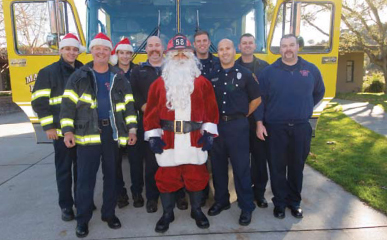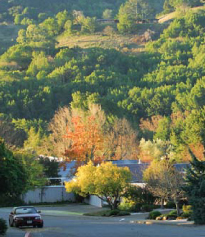More than 50 years ago, that was the Marinwood subdivision. PG&E had installed streetlights and, occasionally, the county sent out crews to trim the median landscaping. That was it. Then, in the late 1950s, in a nod to communities distant from significant cities, the state legislature created Community Services Districts. And Marinwood’s isolated residents jumped at the chance to create a community. By the early 1960s, with the ability to issue bonds, Marinwood was building a fire station, a community center; even buying open space.
Today, Marinwood is still building community. “We’re not at all like a city,” says District Manager Thomas Horne. “Marinwood is strictly a suburban community. We have only limited commercial and absolutely no industrial properties.” Marinwood provides fire protection, runs numerous recreational programs and supervises some 700 acres of parks and open space. To find Marinwood, take Lucas Valley Road off Highway 101 and head west. All the homes on your right represent the community of Marinwood/Lucas Valley. (The area containing over 400 deed-restricted Eichler homes, known as Upper Lucas Valley, is not part of the official Marinwood Community Services District.) In all, says Horne, the Marinwood/Lucas Valley community encompasses more than 6,000 people living on 1,900 acres and is bordered to the north by 700 acres of open space. “It’s pretty idyllic,” Horne says. “We have wide streets, pathways between neighborhoods, trees that change with the season, four school sites, and quick yet unobtrusive access to the freeway.”
But, says 32-year resident Frank Nelson, something is still missing. “We have the outstanding Dixie School District and a fine recreational program,” he allows. “What we lack, however, is a place to gather, a place where the community comes together.” And this is where the community-building is still going on: Nelson, a retired Marin County prosecutor, now chairs the Marinwood Village Task Force, a group of ten residents who’ve been meeting for two years to devise a plan to reconfigure a five-acre commercial property into a complex of retail and service shops and more than 90 residential units, half of which would be affordable housing.
“In addition to a market on a plaza,” says Nelson, “we’re hoping for a friendly coffee shop, maybe a UPS store, things that cause people to come together.” In a true sense of coming together, the task force is working, interestingly enough, with Gerald Hoytt of Hoytt Enterprises in Novato. Hoytt is a familiar name in Marinwood because in the 1950s, the very same “Jerry” Hoytt was the young developer who built Marinwood’s first homes.
Back then those homes sold in the $16,000 to $18,000 range; now they go for up to 50 times that amount. “Last summer, I listed a home at $699,000, but multiple offers brought the selling price up to $775,000,” says realty agent Wayka Bartolacelli, who advertises her- self as “the Marinwood Specialist.” Bartolacelli says a typical updated 1,600-square-foot Marinwood home on a 7,500-square-foot lot sells in the low $800,000s, with the high end of that market reaching almost $1 million.
Homes appear to notably exceed that price point in the deed-restricted Eichler Homes in the community of Upper Lucas Valley. “A fabulous, totally rebuilt Eichler is coming on the market,” remarks realtor Catherine Munson with Lucas Valley Properties, “at $1,340,000.” According to Munson, who has lived in an Eichler home since it was built in 1966, properties regularly sell in the million-dollar range and almost never does a fixer-upper come on the market among the 435 Eichlers, built between 1963 and 1967. “The homeowners association is very active,” she explains, “in enforcing the deed restrictions that control the appearance of homes—from disallowing second-story additions to the palette of colors available when repainting.” As for entry-level prices in either Upper Lucas Valley or nearby Lucas Valley Estates, Munson says, the absolute minimum is “maybe $850,000, and then only very rarely.”
People are drawn to Marinwood/Lucas Valley for its good schools (Dixie School District) and exceptional recreation programs. “And residents like having their own firemen,” says Marinwood Community Services Director Horne. “They build community by leading the Little League’s opening day parade, driving Santa through the neighborhoods, and staging the Fourth of July Pancake Breakfast.”
The Marinwood Community Services District’s rec schedule includes youth skiing and snowboarding trips to Tahoe along with swim meets for the Marinwood Waterdevils (ages five to 18) and, for adults, Italian lessons and trips to China and the French Riviera. Community Services District residents receive reduced rates on some of these programs, which regularly attract participants from outside the district. “Our summer day camps are always a huge success,” says Shane DeMarta, assistant recreation director, “and swimming programs draw people all the way from San Francisco. Everyone wants to go where it’s warm and sunny.”

Firefighters celebrate Christmas at the popular Marinwood station.


